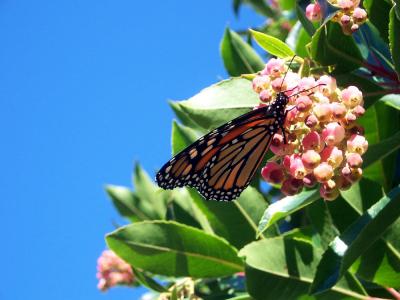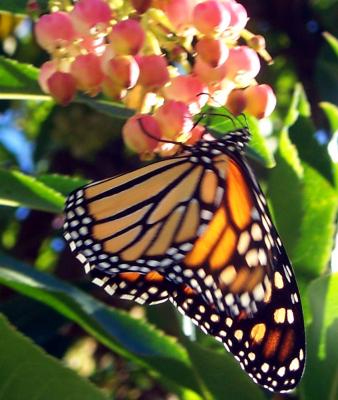

15 points
Regular Animal Documentation by Raymond Luxury Yacht
September 23rd, 2006 12:05 AM
I discovered a Monarch Butterfly on 5th Avenue. It was beautiful. Also, it did not appear to fear my human presence. I took this as a sign. I tried to lick it.
These beautiful insects are in the middle of their regular southward migration. The population west of the Rockies will overwinter in a variety of locations along the California coast.
Stuff to know:
Monarchs and the milkweed plant have a very close relationship. The milkweed relies on insects for pollination by nature of it's pollen clusters while the Monarch is totally dependent on the milkweed plant for sustenance in it's larval state.
Fascinating quote from monarchwatch.org:
"Milkweeds have a unique and fascinating pollination mechanism in which the plant relies on Lepidoptera (butterflies and moths) and Hymenoptera (bees, ants, and wasps) for pollination. Hundreds of pollen grains are packaged into two connected sacs or pollinia, which is collectively referred to as the pollinarium [see SEM photo at right]. When a foraging insect lands on a flower, the pollinarium can easily attach itself to its leg. Once removed from the flower, the pollinia actually re-orient as the translator arms bend as they dry. Upon landing on another flower, the properly oriented pollinarium is deposited into a receptive stigmatic groove where the pollinia breaks down and the pollen germinates, growing pollen tubes through the stigma to the ovules in the ovary."
Not only do Monarchs need the milkweed plant for food in order to grow into their charming (and quite necessary!) pupa (chrysalis) phase, but this is also the source of their ultimate power! Milkweed contains a potent heart poison. Monarchs consume it and store it in their exoskeleton. When vertebrates consume the delicious-looking orange fluttery things, they get really really sick. We're talking "overdid the Irish car-bombs and got wicked food poisoning from that Chinese-Mexican food hybrid joint." Apparently in some regions, the milkweed contains enough of this stuff to kill even Monarch larvae.
Also interesting is that the Monarch migration spans multiple generations and always cover the same route. According to Wikipedia, "the flight patterns are inherited, based on a combination of circadian rhythm and the position of the sun on the sky."
Lastly, I thought it important to make a statement on sexing Monarch Butterflies. Males have a *black spot* on a vein on their rear wings which the females do not. Thus, it is imperative for their survival that the Monarch population does not succomb to the all-to-tempting desire to become pirates. They could face extinction. Don't tell them about pirates!
Note: the tree that the pictured Monarch is feeding from is Arbutus unedo, a small evergreen tree known commonly as Strawberry Tree. It is not native to the region, but rather to the Mediterranean. It is a horticultural plant that appears to do quite well in our city. I also noticed that it tends not to disturb the cement squares of the sidewalk. Obedient. Too obedient, perhaps.
These beautiful insects are in the middle of their regular southward migration. The population west of the Rockies will overwinter in a variety of locations along the California coast.
Stuff to know:
Monarchs and the milkweed plant have a very close relationship. The milkweed relies on insects for pollination by nature of it's pollen clusters while the Monarch is totally dependent on the milkweed plant for sustenance in it's larval state.
Fascinating quote from monarchwatch.org:
"Milkweeds have a unique and fascinating pollination mechanism in which the plant relies on Lepidoptera (butterflies and moths) and Hymenoptera (bees, ants, and wasps) for pollination. Hundreds of pollen grains are packaged into two connected sacs or pollinia, which is collectively referred to as the pollinarium [see SEM photo at right]. When a foraging insect lands on a flower, the pollinarium can easily attach itself to its leg. Once removed from the flower, the pollinia actually re-orient as the translator arms bend as they dry. Upon landing on another flower, the properly oriented pollinarium is deposited into a receptive stigmatic groove where the pollinia breaks down and the pollen germinates, growing pollen tubes through the stigma to the ovules in the ovary."
Not only do Monarchs need the milkweed plant for food in order to grow into their charming (and quite necessary!) pupa (chrysalis) phase, but this is also the source of their ultimate power! Milkweed contains a potent heart poison. Monarchs consume it and store it in their exoskeleton. When vertebrates consume the delicious-looking orange fluttery things, they get really really sick. We're talking "overdid the Irish car-bombs and got wicked food poisoning from that Chinese-Mexican food hybrid joint." Apparently in some regions, the milkweed contains enough of this stuff to kill even Monarch larvae.
Also interesting is that the Monarch migration spans multiple generations and always cover the same route. According to Wikipedia, "the flight patterns are inherited, based on a combination of circadian rhythm and the position of the sun on the sky."
Lastly, I thought it important to make a statement on sexing Monarch Butterflies. Males have a *black spot* on a vein on their rear wings which the females do not. Thus, it is imperative for their survival that the Monarch population does not succomb to the all-to-tempting desire to become pirates. They could face extinction. Don't tell them about pirates!
Note: the tree that the pictured Monarch is feeding from is Arbutus unedo, a small evergreen tree known commonly as Strawberry Tree. It is not native to the region, but rather to the Mediterranean. It is a horticultural plant that appears to do quite well in our city. I also noticed that it tends not to disturb the cement squares of the sidewalk. Obedient. Too obedient, perhaps.
0 vote(s)
Terms
(none yet)2 comment(s)
posted by Raymond Luxury Yacht on September 23rd, 2006 5:11 PM
Thanks, Anna One. I took a slew of pictures in the hopes that I would get one or two good shots. I was so pleased to spy this pleasant fellow out on my licking adventure. He fluttered about so erratically, caring not one lick about me.
Arbutus unedo is an obedient plant indeed. I've been working on Disobedient Nature for some time now and I have been shocked at how large these trees will grow without disturbing the sidewalk. I've seen specimens whose trunks are essentially filling their entire sidewalk-hole and not a buckled paving stone in sight! Their root system must go more downward than parallel to the ground.













an obedient plant? nice pictures!